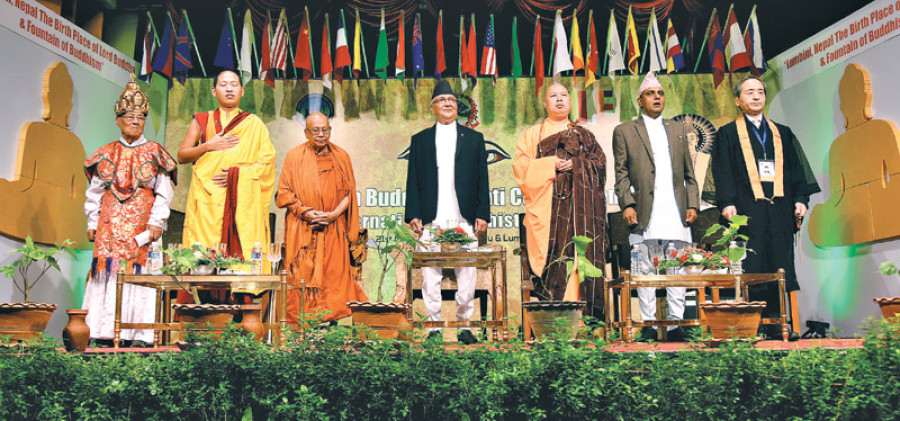Miscellaneous
State-driven spiritualism
Nepal cannot afford to be seen as a proxy for one or the other side in the battle for leadership of the Buddhist world between India and China
It is clear that Prime Minister KP Sharma Oli’s government wants to proactively pursue claims over not just Buddha’s birth, a historical fact, but also over origins of Buddhism itself. While the first issue has been more or less settled politically with Indian Prime Minister Narendra Modi telling the Nepali parliament in 2014 that Buddha was born in Nepal. The second issue, the origin of Buddhism, is a contentious issue that is sure to ruffle feathers in India, if it hasn’t already.
During the opening of the third International Buddhist Conference in Kathmandu on Thursday, both Prime Minister KP Sharma Oli and his culture minister Aananda Prasad Pokhrel made bold claims. “We cannot make a distinction between Lord Buddha and Buddhism. It was through him that the philosophy of Buddhism and enlightenment was born and developed. In fact, the renunciation of all worldly pleasure by Lord Buddha was inspired by his enlightenment. Detaching Buddhism from Lord Buddha and enlightenment from his early life will be a fallacious notion,” said Prime Minister Oli.
Linking Nepali values and identity with Buddha and Buddhism, Prime Minister Oli rued the fact that previous governments had not pursued this issue.
“Buddha was born in Nepal” is a sensitive issue in Nepal and touches a raw nerve of every citizen whenever someone claims otherwise. But the other claim, of Buddhism originating in Nepal, is a new one, and runs the risk of further alienating New Delhi, while giving the nationalist crowd another cause to rally around.
This is in line of a carefully scripted messaging of the Oli government that is increasingly trying to be seen as capable of independently recalibrating its foreign policy goals and priorities.
“We have not been able to glorify our rich civilisations, our oriental values and philosophies on a global scale while our ancestors were the pioneers in leading human civilizations. We must make concerted efforts to project our rich cultural heritage as an embodiment of our collective identity,” said PM Oli during the conference.
In the run up to the conference, Oli had made his government’s intention clear: The conference would serve the purpose of “clarifying myths and fallacies surrounding Buddha’s birth and the origin of Buddhism.” For this he clearly intended to seek international endorsement on Nepal’s claims.
“There is a further need to promote Lumbini as the birthplace of Lord Buddha, as the origin of Buddhism and as a site of world peace. For this, more studies, research and further scholarly engagements will be helpful. This will also need further support and cooperation from the international community. We hope we will continue to get such support in the days ahead as well,” Oli said.
Indian concern
As a matter of principle, religion should transcend nationality, yet in reality it has never been free of politics. India appears concerned by the efforts to give “primacy to Lumbini over Bodh Gaya.” Under Indian Prime Minister Narendra Modi, New Delhi is keen on claiming the leadership of the Buddhist civilisation. Beside, soft power, such a leadership claims, has the potential to bring economic benefits as well. With a vibrant middle class in Southeast Asia, where a large number of Buddhists reside, the potential for religious tourism is immense. It also sits nicely with Modi’s Act East policy. Given what is at stake, losing Bodh Gaya to Lumbini as the Mecca of Buddhist pilgrimage is an unacceptable proposition for an India with global ambitions.
India suspects that Nepal’s new leadership, under the Chinese influence, is attempting to redefine history and establish a different narrative of where Buddhism originated. With scope of huge Chinese investment in infrastructure, the prospect of Lumbini outshining Bodh Gaya isn’t that far-fetched.
Chinese interest
It is difficult to ascertain what Chinese interests are in promoting Lumbini over Bodh Gaya, if the Indian fears are indeed correct. Obviously the Chinese seem to be eager to claim the reigns of leadership in the Buddhist world as evidenced by the communist government regularly hosting or sponsoring Buddhist conferences of late—after decades of suppression. In October 2014, Beijing hosted over 600 international Buddhist delegates from 40 countries in Bajoi in Shaanxi province amid an impressive display of China’s rich Buddhist cultural heritage. Chinese officials describe Buddhism as an important part of their civilisation and that China has been a “gateway” for the flow of Buddhism for nearly two millenniums.
As much as the Chinese would like to wow the international audience, the real reason behind their quest for leadership may be domestic. China is home to an estimated 200-300 million Buddhists, the largest of any country. After years of repression, Buddhism in China has seen a resurgence. Even in its most sensitive region of Tibet, successful claim to leadership of the Buddhist world can help counter the narrative of the Dalai Lama and Tibetans in exile.
As a one party state, the biggest concern of the Chinese leadership is to preserve the status quo politically. One can only speculate that Chinese leaders have not opened up the religious landscape without putting in place a mechanism to ascertain how the religious sentiments translate into political risks for the Communist Party.
Having a Mecca for Buddhism in a friendly country where Beijing would most likely build most of the infrastructure, including hotels and transportation, can help the regime to keep close tabs on the activities of its citizens.
Given the game of high politics being played between India and China, perhaps, it would only stand to reason that Nepal in seemingly seeking to outshine Bodh Gaya treads the path carefully.




 24.02°C Kathmandu
24.02°C Kathmandu









